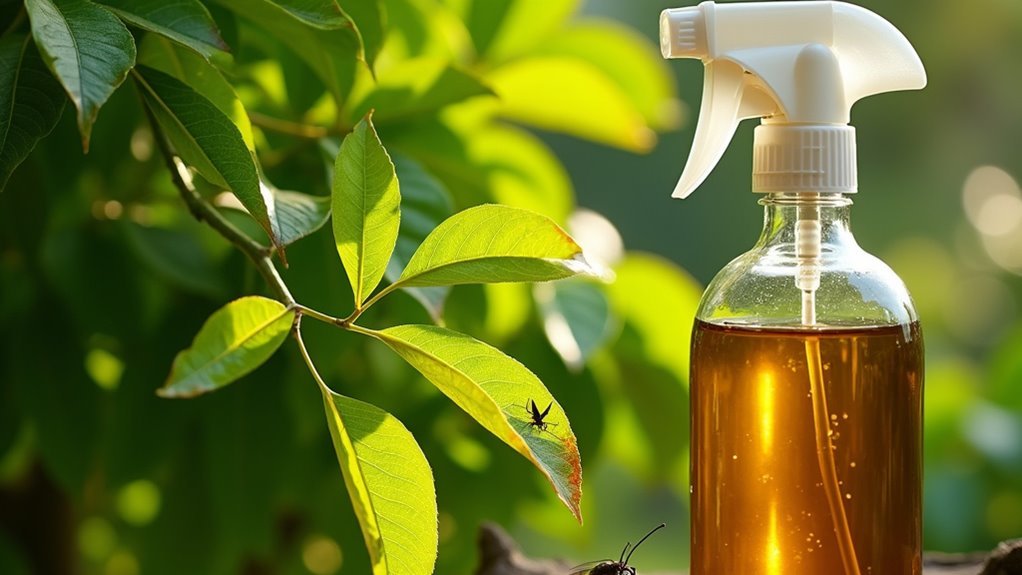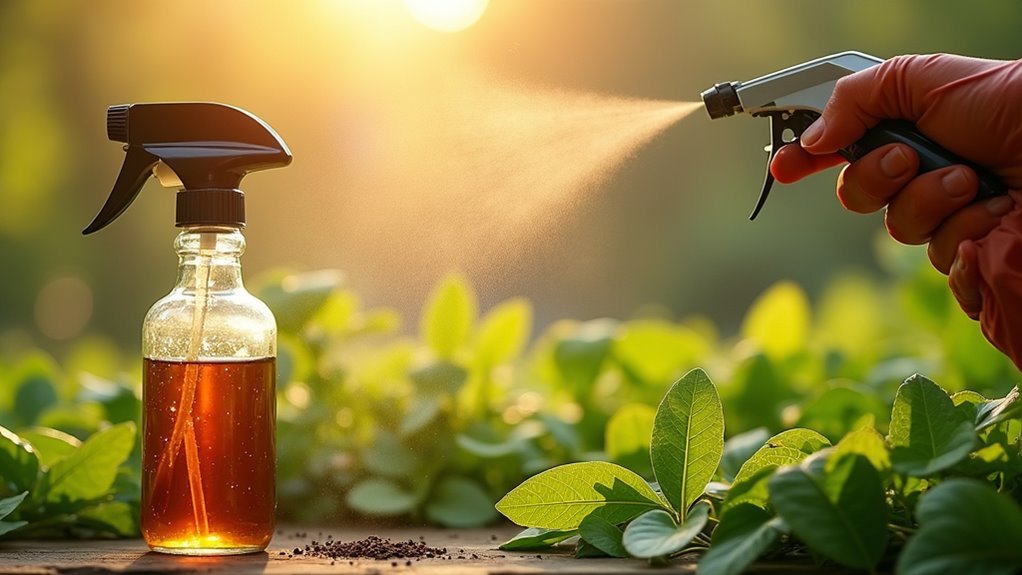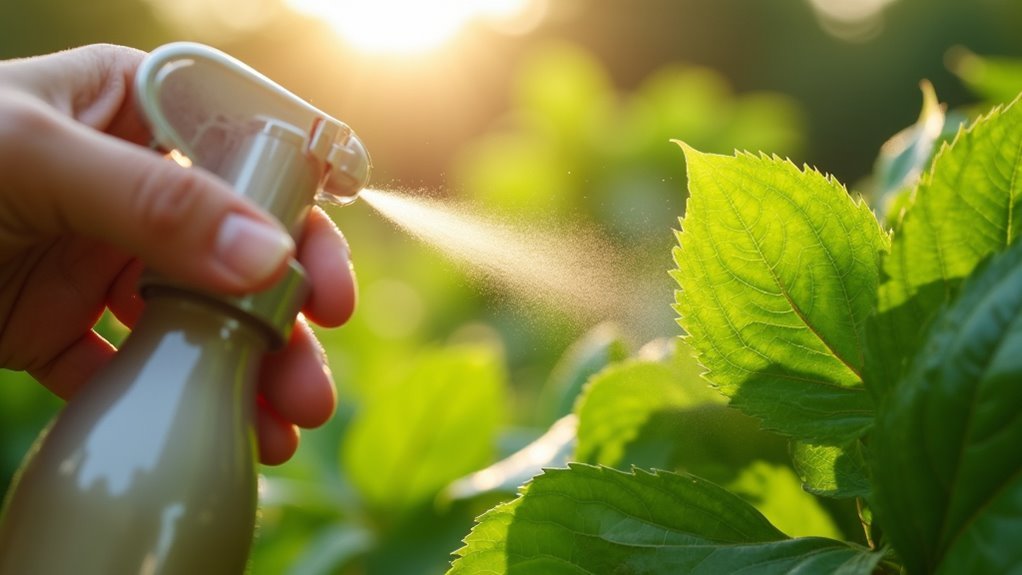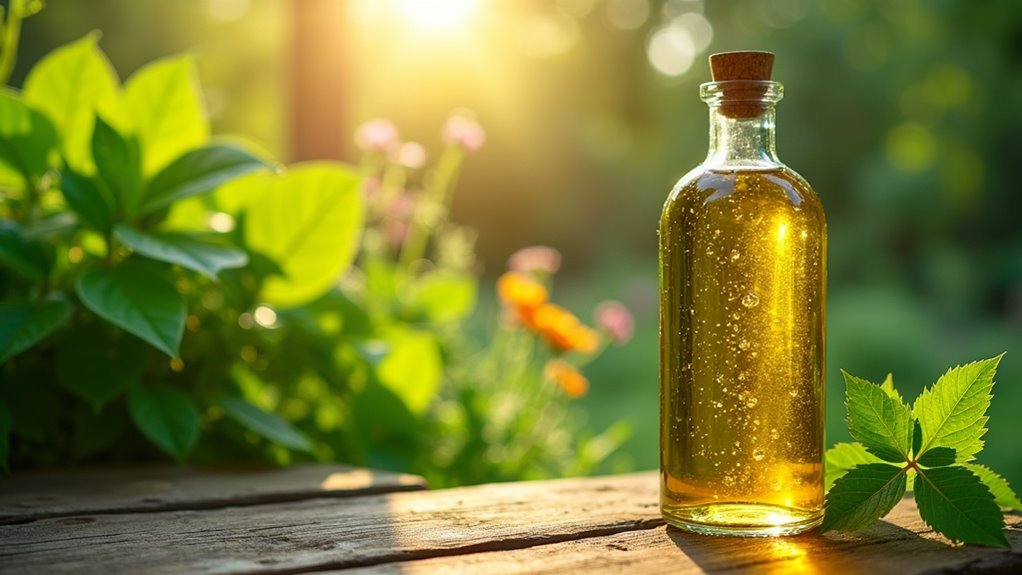You can effectively banish garden pests using neem oil, an organic extract from the neem tree that contains azadirachtin as its active compound. This natural solution disrupts pest feeding and reproduction cycles while combating fungal diseases like powdery mildew. It’s particularly effective against soft-bodied insects such as aphids, spider mites, and whiteflies without harming beneficial pollinators when applied correctly. Understanding proper application methods and timing will maximize your pest control success.
What Is Neem Oil and How Does It Work?

Garden pest-control solutions don’t get much more natural than neem oil, an organic extract derived from the seeds of the neem tree (Azadirachta indica).
Neem oil stands out as one of nature’s most effective and completely organic approaches to garden pest management.
This powerful organic pesticide contains azadirachtin, the primary active compound responsible for its impressive insecticidal properties. When you apply neem oil to your garden, it works through ingestion, disrupting pest feeding patterns and reproductive cycles.
You’ll find it particularly effective against soft-bodied insects like aphids, caterpillars, and spider mites.
Beyond pest control, neem oil also combats fungal diseases such as powdery mildew by preventing spore germination. The oil acts as both a treatment and repellent, making it a versatile tool for maintaining healthy plants naturally.
Target Pests and Diseases Controlled by Neem Oil
You’ll find neem oil targets a wide range of soft-bodied pests like aphids, spider mites, whiteflies, and caterpillars that commonly damage garden plants.
It’s also effective against fungal diseases such as powdery mildew by preventing spore germination before infections take hold.
The oil works by disrupting pest feeding and reproduction cycles, making it particularly powerful against immature insects during their most vulnerable development stages.
Common Garden Pests
When dealing with garden pest problems, neem oil serves as a versatile solution that targets numerous troublesome insects and diseases.
You’ll find this natural pesticide effective against soft-bodied insect pests like aphids, mealybugs, whiteflies, spider mites, and caterpillars. When you spray neem oil regularly, the active compound azadirachtin disrupts these pests’ feeding and growth cycles, making it particularly powerful against immature insects.
Your pest control strategy becomes more thorough since neem oil also tackles fungal issues like powdery mildew by preventing spore germination.
You can safely apply it to houseplants, vegetables, and ornamentals, though sensitive plants may need patch testing. For best results, you’ll want to reapply every 7-14 days to maintain effective garden pests management and prevent future infestations.
Fungal Disease Management
Beyond its impressive pest control capabilities, neem oil’s antifungal properties make it an essential weapon against common garden diseases. As a natural fungicide, it effectively prevents powdery mildew and other fungal diseases by stopping spore germination. The azadirachtin compound doesn’t cure existing infections but prevents disease spread through regular application.
| Disease Type | Prevention Method | Application Frequency |
|---|---|---|
| Powdery Mildew | Spray affected foliage | Every 7-14 days |
| Black Spot | Apply to susceptible plants | Weekly during humid periods |
| Rust Diseases | Target new growth areas | Bi-weekly maintenance |
| Leaf Blight | Preventive foliar treatment | Every 10 days |
You’ll achieve peak fungal diseases management by applying neem oil consistently every 7 to 14 days. This integrated approach enhances your overall pest management strategy while protecting plants naturally.
Pest Life Disruption
Neem oil disrupts the life cycles of numerous garden pests through its systemic interference with their feeding, molting, and reproductive processes.
When you apply neem oil as a spray, the active compound azadirachtin works as a powerful deterrent that prevents target pests from feeding normally on your plants. This disruption affects their ability to grow and reproduce effectively.
You’ll find that regular applications create an inhospitable environment for aphids, mealybugs, whiteflies, caterpillars, and spider mites.
The oil suffocates soft-bodied insects while simultaneously acting as a repellent for future invaders. By consistently using neem oil every 7-14 days, you’re not just treating existing pest problems—you’re actively preventing new infestations from establishing themselves in your garden.
Types of Neem Oil and Their Applications
As you explore neem oil options for your garden, you’ll discover three distinct types, each offering unique pest control mechanisms.
Cold-pressed neem oil stands out as the best choice for home gardeners due to its high azadirachtin content, providing thorough pest control while preserving beneficial insects.
Understanding each type helps you choose the right solution:
- Cold-pressed neem oil – Highest azadirachtin levels, ideal for systemic pest control
- Pure azadirachtin products – Commercial-grade formulations requiring insect ingestion
- Clarified hydrophobic extract – Works by suffocating pests but lacks azadirachtin’s properties
- Proper dilution ratios – Mix neem oil at 1-2 tablespoons per gallon for effective coverage
When you apply neem oil, test a small plant area first to check sensitivity.
Create your neem oil spray using proper dilution rates for best results.
Step-by-Step Application Methods for Maximum Effectiveness

You’ll achieve the best pest control results when you properly mix and apply neem oil using proven techniques.
Your success depends on getting the dilution right, ensuring complete plant coverage, and timing your applications strategically.
Let’s walk through each step to maximize neem oil’s effectiveness in your garden.
Proper Mixing and Dilution
Three critical factors determine whether your neem oil treatment succeeds or fails: proper dilution ratios, effective emulsification, and thorough mixing.
You’ll achieve ideal coverage by following precise measurements and preparation steps that guarantee your solution works effectively against garden pests.
For proper mixing and dilution, follow these essential guidelines:
- Mix 1-2 tablespoons of cold-pressed neem oil per gallon of water, or 1-2 teaspoons per quart for smaller batches
- Always add an emulsifier like insecticidal soap to prevent separation and improve mixing quality
- Shake your sprayer vigorously before each use to distribute the neem oil evenly throughout the solution
- Conduct a patch test on a small plant area first to check for adverse reactions before full application
Apply early morning or late evening for best results.
Thorough Plant Coverage Techniques
Once you’ve prepared your neem oil solution correctly, systematic application techniques guarantee every pest-vulnerable area receives adequate treatment.
Start spraying from the plant’s top, working downward to confirm thorough coverage. Don’t skip leaf undersides where pests commonly hide – flip leaves and spray directly underneath. Apply neem oil until the plant’s wet and dripping, as this contact-based pest control method requires direct coating to work effectively.
Before treating your entire garden, conduct a patch test on one leaf per plant species. Wait 24 hours to check for stress reactions. If plants tolerate the solution well, proceed with full application.
Monitor plants closely after each treatment. When pests persist, reapply solution every 3-4 days, maintaining consistent coverage patterns for best results.
Timing and Reapplication Schedule
The timing of your neem oil applications determines whether you’ll achieve effective pest control or waste your efforts.
Strategic scheduling guarantees maximum impact against garden pests while protecting your plants.
For active infestations, you’ll need aggressive treatment schedules:
- Apply neem oil every 3-4 days when pests are present, saturating all plant surfaces including leaf undersides.
- Reapply 7-10 days after your first application to eliminate remaining insects that survived initial treatment.
- Continue monitoring pest populations and maintain treatments until you observe significant reduction.
- Use neem oil as a preventative measure every 10-14 days during peak pest seasons.
Always check weather forecasts before application.
Rain shortly after treatment washes away the product, reducing effectiveness.
Consistent reapplication combined with careful monitoring creates the most effective pest management strategy.
Timing and Reapplication Guidelines for Optimal Results

While neem oil can effectively control garden pests, you’ll achieve the best results by applying it at strategic intervals based on your specific pest situation.
For effective pest control during active infestations, reapply every 3-4 days until you’ve eliminated the problem. When using preventative measures, extend the interval to every 10-14 days to stop infestations before they begin.
Timing matters greatly for protecting beneficial insects. Apply neem oil during early morning or late evening hours when these helpful creatures are less active.
You’ll need consistent application since the oil dries within 45 minutes to an hour, losing its effectiveness afterward. Always reapply after rainfall, as water washes away the treatment and reduces its pest-controlling properties.
Safety Considerations and Environmental Benefits
Although neem oil offers effective pest control, you’ll be pleased to know it’s one of the safest options for your garden environment. This biodegradable solution has low toxicity to beneficial insects like bees and birds, making it environmentally friendly compared to harsh chemical pesticides.
Key safety and environmental benefits include:
- Safe around pets and livestock when applied properly, though you should keep it away from water bodies to protect aquatic life
- Breaks down rapidly in soil, reducing long-term ecological impact for sustainable gardening
- Best applied during early morning or evening hours to minimize impact on pollinators
- Supports soil health by enhancing nutrient availability while reducing pesticide resistance risks
You’re contributing to healthier ecosystems while effectively managing garden pests.
Frequently Asked Questions
What Plants Not to Use Neem Oil On?
Don’t use neem oil on sensitive ferns, stressed plants, Asteraceae family flowers, young seedlings, or newly transplanted plants. You’ll risk leaf burn and damage. Always test a small area first before applying to check for adverse reactions.
Does Rain Wash off Neem Oil?
Yes, rain washes off neem oil and markedly reduces its effectiveness. You’ll need to reapply it after rain events. Check weather forecasts before application and avoid spraying if rain’s expected soon.
What Are the Downsides of Neem Oil?
You’ll face several downsides: neem oil can harm beneficial insects, cause plant sensitivity, lose effectiveness through overuse, require frequent reapplications since it’s contact-only, and it’s toxic to aquatic life.
Why Is Neem Oil Banned as a Pesticide?
You’ll find neem oil banned because it harms beneficial insects like bees, threatens aquatic life, lacks long-term safety data, and doesn’t meet regulatory standards for certain crops or organic farming practices.
In Summary
You’ve now got the knowledge to tackle garden pests naturally with neem oil. Remember, it’s not just about spraying and hoping—you’ll need to apply it consistently, target the right pests at the right time, and follow safety guidelines. With proper timing and technique, you’ll protect your plants while keeping beneficial insects safe. Start incorporating neem oil into your garden routine today and watch your pest problems disappear organically.





Leave a Reply